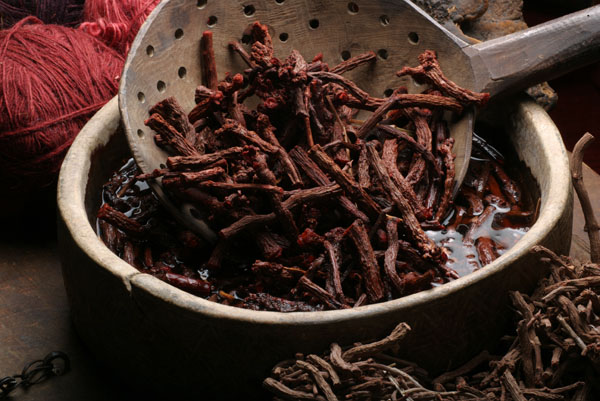Natural dyes is far superior to chemical dyes for certain reasons:
- - With exposure to light all
color
fades, but natural dyes fade or mellow leaving lighter tones that are
just as beautiful, if not more so, than the original colour.
- - Natural dyes are more compatible and harmonious with one another.
By contrast, chemical colors are easy to use and can produce good
results, but have certain drawbacks, in that they can look hard or
garish; some fade very quickly, and others fade unevenly leaving
blotches.
-
- One of the key reasons why natural
colors look better
than chemical colors because they are not 'pure' color: a natural red, for
example, will include blue and yellow, whereas a chemical red will only contain
red pigment. The impurities of natural dyes, which may comprise from five to 25
percent of the dye, consist of other hues that are similar to the main one, and
it is these mixtures that make natural dyes so beautiful and create their
harmony with neighboring natural colors. Where one person will see some purple
in a hank of gray yarn, another may see some blue in it. To be able to see the
difference is partly genetic, like the ability to curl one's tongue lengthwise,
and partly a matter of experience. On the other hand, evenness of a
synthetically dyed carpet is flat and uninteresting. Natural dye, precisely
because of its unevenness, makes color vibrate or sparkle. And for some people
this "imperfection," a sign of the artist's hand working natural substances from
the garden or fields, has spiritual overtones.
-
-
Natural
dyes make different shades at the different time of the day. When these natural
dyes expose to the light, they leave lighter tones, which makes them to look
beautiful in different way than their original colors.
-
- Natural-dye enthusiasts see
"mellow" hues that sparkle and glow which give esthetically comfortable feeling.
But to be able to see these features one needs, perhaps, a passion for color.
-
- Natural dyes are substantially less destructive to the
environment than the chemical dyes widely in use.
Synthetic dyes used in textile dyeing
generally cause environmental pollution and health problems in humans.
-
- Each plant provides an amazing diversity of shades. From
one plant one may obtain between 5-15 varying colors and shades. These
colors and shades are subtle and tend to harmonize with one another. The
resulting fabrics or fibres are now original pieces - it is extremely difficult
for anyone to duplicate exactly (even the dyer)€
-
- Natural
color is inherently
more muted than chemical color, which looks very stark, and so if chemical
colors are used while the desired effect is for the 'natural' look, it will be
necessary to mix a variety of colors in imitation of nature.
-
- Color created from natural
elements lasts much longer than chemical dyes.
|


